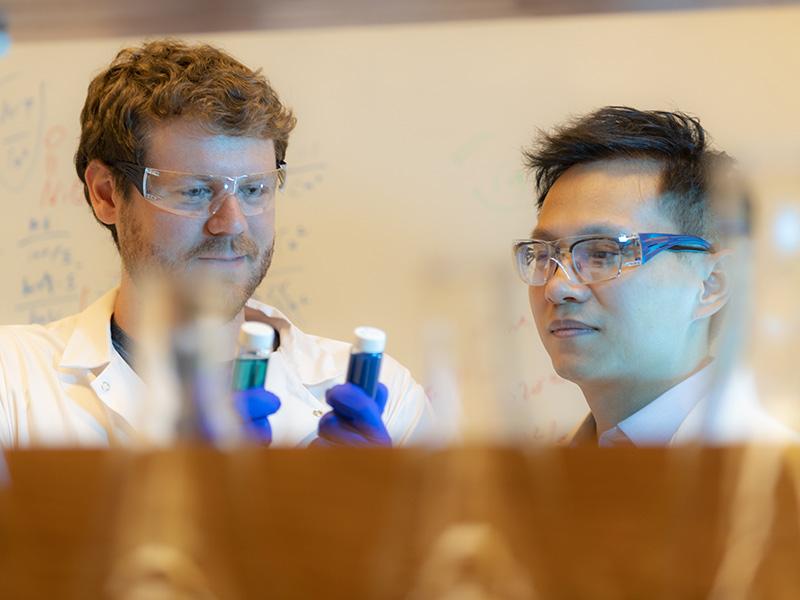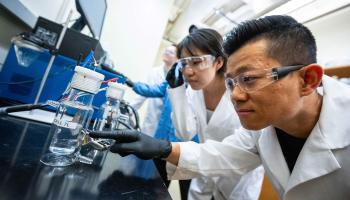Superstructure Synthesis Breakthrough Could Transform U.S. Energy and Manufacturing Industries

In 2021, the manufacturing sector of the U.S. economy accounted for over a quarter of the country’s total energy consumption, according to the U.S. Energy Information Administration, and over 80% of that energy is still produced by fossil fuels that are contributing to a global climate-change crisis. Consequently, the Department of Energy has identified innovations in precise and scalable manufacturing as a technological priority. Addressing this need, a team of scientists led by chemist Sen Zhang, an associate professor with the University of Virginia’s College and Graduate School of Arts & Sciences in collaboration with professor William Goddard from Caltech and researchers from the Department of Energy’s Argonne, Ames, and Oak Ridge National Laboratories, have announced their discovery of a process for producing a new form of synthetic materials that could have a variety of promising uses, including helping to make the manufacturing industry more energy efficient.
The materials that modern societies and their economies need, from the cardboard of a coffee cup to the silicon of semiconductors, are developed through careful engineering that involves developing their unique properties at the atomic level. Innovations that allow scientists to arrange atoms with that level of precision and to scale those processes up to allow for mass production are driving further breakthroughs that continue to improve those materials, but those improvements are still limited by the physical properties of those materials. Zhang and his research team, however, have developed a method for building new kinds of materials known as superstructures that are built from distinct clusters (units built of tens to hundreds of atoms) arranged into a repeating pattern that resembles the way that atoms come together to form solid materials. The discovery could lead to the development of materials that can be engineered to have improved properties better suited to the needs of industry.
While superstructures have been the focus of much scientific research, they have been difficult to generate at scales large enough for scientists to study consistently, and how they form has remained elusive. However, the method developed by Zhang and his team has produced superstructures in amounts that previously were unattainable. Moreover, the superstructures are generated over the course of hours in a manner that allows them to be studied as they are built, contributing to a deeper understanding of how the process occurs. The discovery could be the foundation for developing new kinds of materials engineered with even greater precision for more specific applications.
“In this work, we developed a method that uses atomically precise cerium oxide nanoclusters as building blocks in the self-assembly of superstructures at a large scale in a one-step synthesis,” Zhang said. “This method is highly controllable, allowing for the control of materials’ chemical compositions, and it has been generalized and extended to other rare earth metal oxides with elements such as lanthanum, samarium, or gadolinium, which may also have diverse industrial applications. By collaborating with scientists at Caltech in computation and Argonne, Ames, and Oak Ridge National Laboratories in materials characterization, we have revealed the mechanism of this synthesis method and found that it is driven by interactions between the organic molecules that bind to the surface of these nanoclusters and stabilize them.”
The discovery, Zhang explained, could lead to the development of materials that are more sensitive to light and electrons and transfer energy more efficiently, which could potentially make solar cells, photodetectors, and sensors better and more energy efficient and even help in the development of next-generation quantum computing devices. Some of the materials, which have already shown promise on a smaller scale, could also be used for the catalytic conversion of CO2 and plastic waste.
“Superstructures can also display distinct mechanical and magnetic properties, making our materials lighter and more robust, and our magnets more precise,” said Grayson Johnson, lead author of the paper Zhang’s team has published in Nature Synthesis, a sister journal of Nature, and the world’s leading journal in chemical and materials synthetic sciences “Superstructures may also be used for catalysis and batteries, leading to more cost-effective materials for a clean energy future. This is the starting point for generating a diverse and new library of materials that we now have the space to explore.”
“This is a great example of cross-disciplinary and cross-institution collaboration leading to critical scientific advances in materials manufacturing,” Zhang said. “Manufacturing is central to the nation’s prosperity and security, and the new materials and new method created in this work will lay a solid foundation for further collaboration and lead to new research and new opportunities for training a next-generation workforce.”
“In this work, the Zhang team at UVA has unraveled an important high-temperature ligand switching mechanism that can control the self-assembly process to form superstructures from atomically precise rare earth metal oxide nanoclusters,” said Hua Zhou of Argonne National Laboratory and one of the paper’s co-authors. “These superstructured nanomaterials with atomically precise building blocks are highly desirable for various functional applications in energy and electronics but have rarely been realized so far. In this discovery, operando small angle X-ray scattering, a powerful synchrotron X-ray technique we have utilized at the Argonne National Laboratory’s Advanced Photon Source (APS), a U.S. Department of Energy Office of Science user facility at Argonne, has played a very critical role providing information about the nanocluster nucleation, superstructure ordering and assembly pathways. The superstructure assembly is a dynamic process which was unable to be captured by ex-situ measurements at a few defined time stamps.”
Prof. William A. Goddard III of Caltech, said that the experimental confirmation at the APS of the mechanism discovered from computation, now enables theory and computation to play a role in finding improved systems to predict the best materials combinations prior to experiment, synthesizing only the best predicted combinations of materials.








